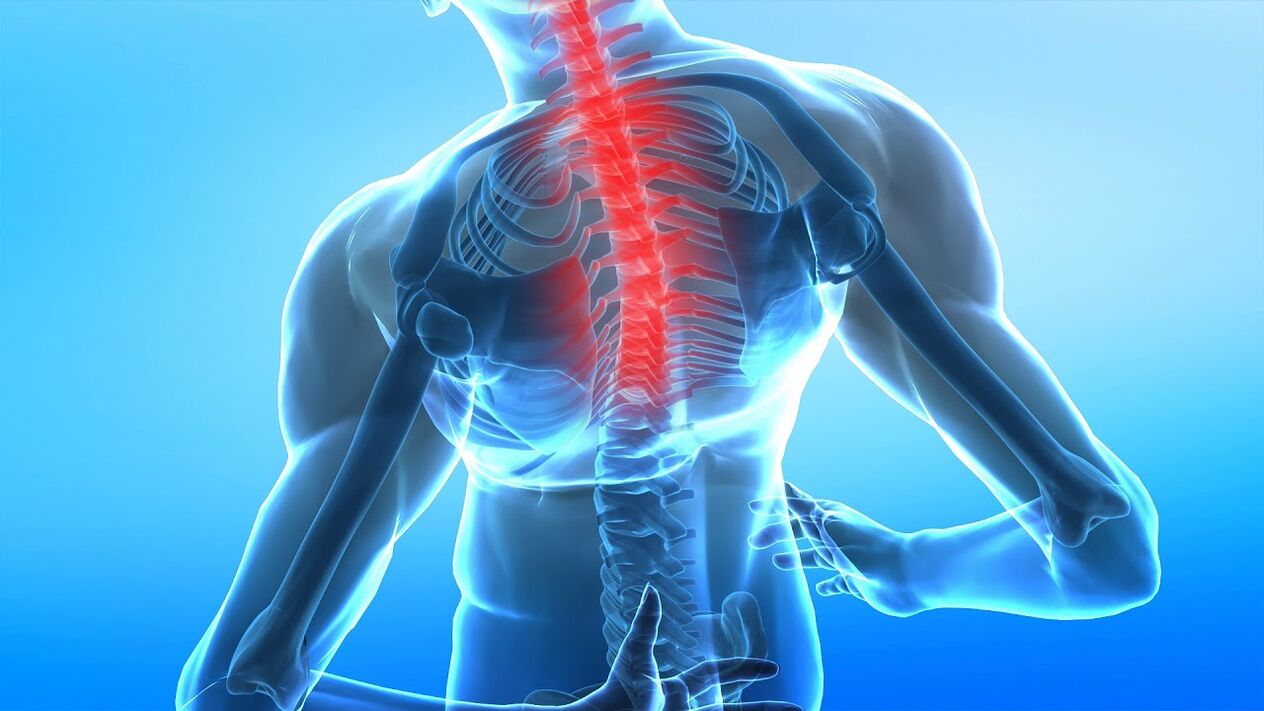Spinal fibroids are a complex disease that can affect the thoracic, lumbar, and cervical spine. Review of the most common symptoms and features of home treatment.

Common symptoms of osteonecrosis of the spine
Spinal osteomas occur in 60-70% of people past the age of 40. Recently, cases of 20 - 30 year olds with osteonecrosis are not uncommon.
Depending on which part of the spine is affected by the disease, its clinical picture is determined. The defeat of the cervical region is characterized by the appearance of the following symptoms:
- Dizziness occurs spontaneously and is aggravated by turning the head (especially with sudden movements);
- Headaches that don't get better with pain relievers. Pain is usually caused by motor activity in the cervical region;
- Shoulder and neck pain, numbness in the upper extremities;
- Violation of vision: weakness, flickering before the eyes of "flies" and multicolored circles;
- Hearing loss: tinnitus feeling;
- Episodes of loss of consciousness;
- Snoring in a dream is the result of constant tension in the neck muscles;
- In more severe cases, neurological symptoms occur: numbness of the tongue, changes in voice, etc. v.
For thoracic osteonecrosis are characteristics:
- Pain in the chest, shoulder blades, irritation from physical activity, hypothermia. The pain is most often present at night. Increased pain can be triggered by taking a deep breath;
- Feeling of chest compression and sharp pain in the intercostal area (especially when changing positions and movements of the body);
- Feeling of "crawling" on the chest and arms, sometimes - the neck. Numbness and cold extremities.
The basis of clinical symptoms of osteonecrosis, localized in the lumbar region, are symptoms such as:
- Pain syndrome localized in the lumbar region. It can be painful, permanently or periodically in the form of "low back pain" with irradiation to the right or left leg, as well as the perineum, sacrum. The pain is significantly increased with exercise and physical activity;
- Numbness and coldness of the lower extremities, decreased sensitivity in the legs;
- With the defeat of the motor parts of the nervous chain, the development of paralysis and paralysis of the legs is possible;
- Dysfunction of the organs of the genitourinary system.
How to get rid of osteonecrosis at home without drugs
To treat osteonecrosis at home without drugs, people often apply remedies of plant and animal origin. Preference is given to the following:
- venom of bees and snakes;
- badger grease;
- Fir essential oil;
- Camphor alcohol, etc. v.
These substances can be used as ointments, compresses, massages.
To alleviate the symptoms and reduce the progression of the disease, it is recommended to use special types of orthopedic beds: mattresses and pillows. In addition, special needles can be used at home to improve blood circulation in tissues and relax muscles.
Proper nutrition plays an important role in the treatment of osteonecrosis. To improve the condition of cartilage and vertebrae, alcohol, coffee, tea, spicy foods, foods containing a lot of exploitative substances (fatty fish, mushrooms) should be excluded from the diet;
Add to your diet foods and dishes that help restore and maintain the integrity of cartilage tissue: lean meat and fish, dairy products.
At home, you can also get the help of a professional masseuse, who will help relieve muscle tension in any part of the spine. With caution, you can do the massage yourself. Self-massage includes caressing, massaging, and kneading.
How to treat osteonecrosis at home with medicine
Medicines for the treatment of any disease, including osteonecrosis, should be prescribed by a qualified specialist. Only a doctor can prescribe an exact treatment regimen, taking into account all contraindications to taking one or another group of drugs. Currently, the following classes of drugs are used to treat osteonecrosis:
- Non-steroidal anti-inflammatory drugs. They can be used as powders, tablets - for systemic use, as well as ointments and gels - for topical use. The former has a more pronounced effect;
- Pain relievers (pain relievers);
- Muscle relaxants and antispasmodics. Eliminate muscle spasms and pathological strains;
- Preparations for improving microcirculation and blood rheology;
- Chondroprotectors. Provides resistance to the effects of negative factors for cartilage;
- Vitamins - mainly group B (B1, B6, B12). Positively affects metabolic processes in the nervous system;
- Antidepressants. Provides prevention of the occurrence of disorders of psychiatric origin.
How to cure osteonecrosis at home with exercises
For osteonecrosis of individual spines, orthopedists and rehabilitators have developed specialized complex therapy exercises. To benefit from exercise, you must follow a few simple rules:
- Use specially designed complexes;
- Movements should not cause discomfort and pain;
- Movements should be smooth, precise, slow;
- You need to do the exercises regularly. Even the least amount of time spent in the day will bring amazing benefits to the spine.
- Complex exercise therapy should be performed only during remission.
In addition to complex therapeutic exercises, doctors strongly recommend always being physically active. Swimming and water aerobics, accessible to everyone at any time of year, perfectly lifts the back muscles.
Note: any treatment for osteonecrosis must be approved by the attending physician. Only in this case can you count on the maximum effectiveness of the therapy.

























